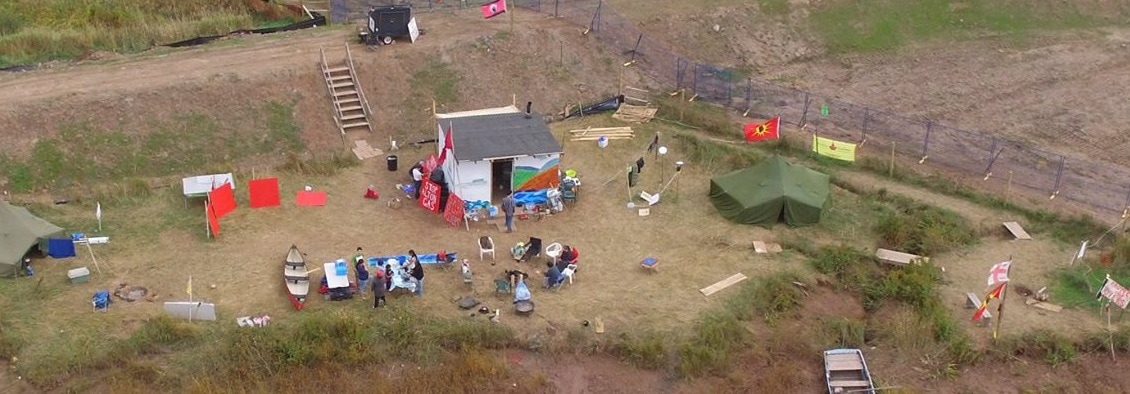KJIPUKTUK (Halifax) – Embattled Alton Gas is indefinitely delaying brining– the creation of caverns out of underground salt beds. This comes after the provincial government had earlier stopped the project in 2014 and ordered an aboriginal consultation process that took almost two years to conclude.
The new delay is merely the latest chapter in the company’s struggle to overcome obstacles that result from a fundamental lack of social license.
Alton Gas isn’t willing to admit to any delay, and speaks of continuing construction, vaguely announcing that brining operations will now begin in 2017. But the two sites of the project- the brine discharge facility on the Shubenacadie River and the storage cavern site in Brentwood- have been ready to operate since October.
Alton Gas jumped the gun on approvals
As is typical in Nova Scotia, the project had just been sailing along in 2014. Successive Nova Scotia governments were favourably disposed to the project, and the current Liberal government is no exception.
Historically, large and complex projects in Nova Scotia have received only cursory scrutiny. Confident that the various approvals will be granted when needed, proponents typically begin ‘putting shovels in the ground’ with some approvals still pending, and others not even applied for.
The ministerial approval of an Environmental Assessment (EA) is really only the start of a regulatory process. The 2007 Alton Gas EA set out 4 major approvals the project would require. The ‘kingpin’ and first approval required in that process was the Nova Scotia Environment Industrial Approval for operating the brine discharge facility at the Shubenacadie River.
So confident was Alton Gas, that when the project was halted in August 2014 to back up for aboriginal consultation, the earthworks and equipment at the river facility were only a few months from completion, the 12 kilometre water and brine pipeline between the two sites had a 20 metre cleared right of way and the pipes buried, and wells had been drilled at the storage cavern site.
Yet Alton Gas had not even applied for an Industrial Approval.
Corporate complacency backfires
In 2014 things began to get off the rails. The turning point was the onset of Mi’kmaq protests against the project at that time, and the increased public scrutiny on all aspects of the project that implied.
Not only did “forgetting” about aboriginal consultation cost Alton Gas a two year delay, all of a sudden the outstanding approvals identified in the 2007 EA became more serious hurdles.
The uncertainty around aboriginal consultation is likely the primary reason that Alton Gas has held off indefinitely on brining and discharge into the Shubenacadie River. Counter to the claims by the Liberal government, no one really knows how to get resolution on the questions of Treaty and aboriginal rights.
Sipekne’katik and Millbrook First Nations still dispute that they have been consulted, and continue to make demands on Alton Gas and the provincial government. The Sipekne’katik First Nation has taken the government to court.
Even if the Sipekne’katik First Nation loses the current court case, it is not clear that the legal and constitutional requirements of aboriginal consultation will be met sufficiently for Alton Gas to begin operations.
One step forward, one step back
The awakened public scrutiny in 2014 put at risk the regulatory approvals previously taken for granted by Alton Gas. The company in 2015 hired Karen White, very recently an employee of the Department of Energy, as a lobbyist to make headway with the outstanding approvals. Remarkably, White was virtually exempted from the mandatory “cooling off period” required of former civil servants.
It appears that White was able to facilitate the granting this year of the crucial Industrial Approval allowing Alton Gas to operate, and both the river and salt cavern sites were busy this summer with the completion of the delayed construction work.
But as construction proceeded, Mi’kmaq led protests continued to escalate, unnerving both Alton Gas and the Liberal government. The combination of uncertainties around regulatory approvals still to be issued, and uncertainties around the government’s aboriginal consultation “problem,” continues to plague this project.
A future Nova Scotia Advocate article will address difficulties with the other regulatory processes that keep the Alton Gas lobbyist busy.
If you can, please support the Nova Scotia Advocate so that it can continue to cover issues such as poverty, racism, exclusion, workers’ rights and the environment in Nova Scotia.




